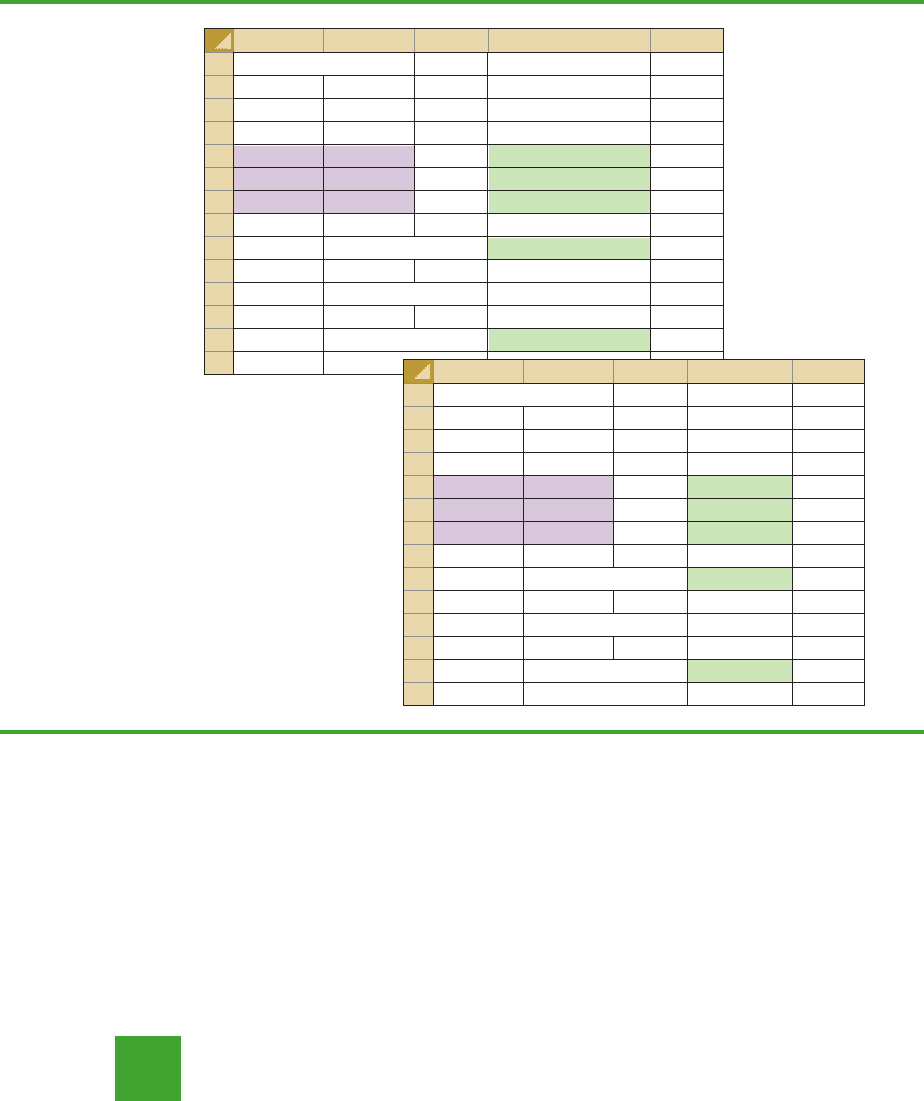Anderson D.R., Sweeney D.J., Williams T.A. Essentials of Statistics for Business and Economics
Подождите немного. Документ загружается.


Supplementary Exercises 475
Use α ⫽ .05 and test to determine whether the job satisfaction for computer programmers
is different from the job satisfaction for IS managers.
39. A sample of parts provided the following contingency table data on part quality by pro-
duction shift.
Region
Eastern Western
Employment Status Edition Edition
Full-time 1105 574
Part-time 31 15
Self-employed/consultant 229 186
Not employed 485 344
Use α ⫽ .05 and test the hypothesis that part quality is independent of the production shift.
What is your conclusion?
40. The Wall Street Journal Subscriber Study showed data on the employment status of sub-
scribers. Sample results corresponding to subscribers of the eastern and western editions
are shown here.
Loan Approval Decision
Loan Officer Approved Rejected
Miller 24 16
McMahon 17 13
Games 35 15
Runk 11 9
Use α ⫽ .05 and test the hypothesis that employment status is independent of the region.
What is your conclusion?
41. A lending institution supplied the following data on loan approvals by four loan officers.
Use α ⫽ .05 and test to determine whether the loan approval decision is independent of
the loan officer reviewing the loan application.
Number Number
Shift Good Defective
First 368 32
Second 285 15
Third 176 24
42. APew Research Center survey asked respondents if they would rather live in a place with
a slower pace of life or a place with a faster pace of life (USA Today, February 13, 2009).
Consider the following data showing a sample of preferences expressed by 150 men and
150 women.
Preferred Pace of Life
Respondent Slower No Preference Faster
Men 102 9 39
Wo
men 111 12 27
CH011.qxd 8/16/10 6:57 PM Page 475
Copyright 2010 Cengage Learning. All Rights Reserved. May not be copied, scanned, or duplicated, in whole or in part. Due to electronic rights, some third party content may be suppressed from the eBook and/or eChapter(s).
Editorial review has deemed that any suppressed content does not materially affect the overall learning experience. Cengage Learning reserves the right to remove additional content at any time if subsequent rights restrictions require it.

476 Chapter 11 Comparisons Involving Proportions and a Test of Independence
a. Combine the samples of men and women. What is the overall percentage of respon-
dents who prefer to live in a place with a slower pace of life? What is the overall per-
centage of respondents who prefer to live in a place with a faster pace of life? What is
your conclusion?
b. Is the preferred pace of life independent of the respondent? Use α ⫽ .05. What is your
conclusion? What is your recommendation?
43. Barna Research Group collected data showing church attendance by age group (USA
Today, November 20, 2003). Use the sample data to determine whether attending church
is independent of age. Use a .05 level of significance. What is your conclusion? What
conclusion can you draw about church attendance as individuals grow older?
45. A salesperson makes four calls per day. A sample of 100 days gives the following fre-
quencies of sales volumes.
Church Attendance
Age Ye s N o Total
20 to 29 31
69 100
30 to 39 63 87 150
40 to 49 94 106 200
50 to 59 72 78 150
Occupancy Status Los Angeles San Diego San Francisco San Jose
Occupied 160 116 192 174
Vacant 40 34 33 26
Observed Frequency
Number of Sales (days)
030
132
225
310
43
Total 100
44. The office occupancy rates were reported for four California metropolitan areas. Do the
following data suggest that the office vacancies were independent of metropolitan area?
Use a .05 level of significance. What is your conclusion?
Records show that sales are made to 30% of all sales calls. Assuming independent sales
calls, the number of sales per day should follow a binomial distribution. The binomial
probability function presented in Chapter 5 is
For this exercise, assume that the population has a binomial distribution with n ⫽ 4,
p ⫽ .30, and x ⫽ 0, 1, 2, 3, and 4.
a. Compute the expected frequencies for x ⫽ 0, 1, 2, 3, and 4 by using the binomial prob-
ability function. Combine categories if necessary to satisfy the requirement that the
expected frequency is five or more for all categories.
f(x) ⫽
n!
x!(n ⫺ x)!
p
x
(1 ⫺ p)
n⫺x
CH011.qxd 8/16/10 6:57 PM Page 476
Copyright 2010 Cengage Learning. All Rights Reserved. May not be copied, scanned, or duplicated, in whole or in part. Due to electronic rights, some third party content may be suppressed from the eBook and/or eChapter(s).
Editorial review has deemed that any suppressed content does not materially affect the overall learning experience. Cengage Learning reserves the right to remove additional content at any time if subsequent rights restrictions require it.

Appendix 11.1 Inferences About Two Population Proportions Using Minitab 477
b. Use the goodness of fit test to determine whether the assumption of a binomial distri-
bution should be rejected. Use α ⫽ .05. Because no parameters of the binomial dis-
tribution were estimated from the sample data, the degrees of freedom are k ⫺ 1 when
k is the number of categories.
Case Problem A Bipartisan Agenda for Change
In a study conducted by Zogby International for the Democrat and Chronicle, more than
700 New Yorkers were polled to determine whether the New York state government works.
Respondents surveyed were asked questions involving pay cuts for state legislators,
restrictions on lobbyists, terms limits for legislators, and whether state citizens should be
able to put matters directly on the state ballot for a vote. The results regarding several pro-
posed reforms had broad support, crossing all demographic and political lines.
Suppose that a follow-up survey of 100 individuals who live in the western region of
New York was conducted. The party affiliation (Democrat, Independent, Republican) of
each individual surveyed was recorded, as well as the responses to the following three
questions.
1. Should legislative pay be cut for every day the state budget is late?
Yes ____ No ____
2. Should there be more restrictions on lobbyists?
Yes ____ No ____
3. Should there be term limits requiring that legislators serve a fixed number of years?
Yes ____ No ____
The responses were coded using 1 for a Yes response and 2 for a No response. The com-
plete data set is available on the data disk in the data set named NYReform.
Managerial Report
1. Use descriptive statistics to summarize the data from this study. What are your pre-
liminary conclusions about the independence of the response (Yes or No) and party
affiliation for each of the three questions in the survey?
2. With regard to question 1, test for the independence of the response (Yes and No)
and party affiliation. Use α ⫽ .05.
3. With regard to question 2, test for the independence of the response (Yes and No)
and party affiliation. Use α ⫽ .05.
4. With regard to question 3, test for the independence of the response (Yes and No)
and party affiliation. Use α ⫽ .05.
5. Does it appear that there is broad support for change across all political lines? Explain.
Appendix 11.1 Inferences About Two Population Proportions
Using Minitab
Confidence Intervals and Hypothesis Tests
We describe the use of Minitab to develop confidence intervals and conduct hypothesis tests
about the difference between two population proportions. We will use the data on tax prepa-
ration errors presented in Section 11.1. The sample results for 250 tax returns prepared at
office 1 are in column C1 and the sample results for 300 tax returns prepared at office 2 are
in column C2. Yes denotes an error was found in the tax return and No indicates no error was
file
W
EB
TaxPrep
file
W
EB
NYReform
CH011.qxd 8/16/10 6:57 PM Page 477
Copyright 2010 Cengage Learning. All Rights Reserved. May not be copied, scanned, or duplicated, in whole or in part. Due to electronic rights, some third party content may be suppressed from the eBook and/or eChapter(s).
Editorial review has deemed that any suppressed content does not materially affect the overall learning experience. Cengage Learning reserves the right to remove additional content at any time if subsequent rights restrictions require it.

478 Chapter 11 Comparisons Involving Proportions and a Test of Independence
found. The procedure we describe provides both a 90% confidence interval estimate of the
difference between the two population proportions and hypothesis testing results for
vs.
Step 1. Select the Stat menu
Step 2. Choose Basic Statistics
Step 3. Choose 2 Proportions
Step 4. When the 2 Proportions (Test and Confidence Interval) dialog box appears:
Select Samples in different columns
Enter C1 in the First box
Enter C2 in the Second box
Select Options
Step 5. When the 2 Proportions-Options dialog box appears:
Enter 90 in the Confidence level box
Enter 0 in the Test difference box
Enter not equal in the Alternative box
Select Use pooled estimate of p for test
Click OK
Step 6. Click OK
Step 5 may be modified to provide different confidence levels, different hypothesized
values, and different forms of the hypotheses.
In the tax preparation example, the data are qualitative.Yes and No are used to indicate
whether an error is present. In modules involving proportions, Minitab calculates
proportionsfortheresponsecomingsecondin alphabetic order.Thus,inthetaxpreparation
example, Minitab computes the proportion of Yes responses, which is the proportion we
wanted.
If Minitab’s alphabetical ordering does not compute the proportion for the response of
interest, we can fix it. Select any cell in the data column, go to the Minitab menu bar, and
select Editor ⬎ Column ⬎ Value Order. This sequence will provide the option of entering
a user-specified order. Simply make sure that the response of interest is listed second in the
define-an-order box. Minitab’s 2 Proportion routine will then provide the confidence inter-
val and hypothesis testing results for the population proportion of interest.
Finally, we note that Minitab’s 2 Proportion routine uses a computational procedure
different from the procedure described in the text. Thus, the Minitab output may provide
slightly different interval estimates and slightly different p-values. However, results from
the two methods should be close and are expected to provide the same interpretation and
conclusion.
Appendix 11.2 Tests of Goodness of Fit and Independence
Using Minitab
Goodness of Fit Test
This Minitab procedure can be used for a goodness of fit test of a multinomial population.
The user must obtain the observed frequency and the hypothesized proportion for each of
the k categories. The observed frequencies are entered in Column C1 and the hypothesized
proportions are entered in Column C2. Using the Scott Marketing Research example pre-
sented in Section 11.2. Column C1 is labeled Observed and Column C2 is labeled Propor-
tion. Enter the observed frequencies 48, 98, and 54 in Column C1 and enter the
H
a
: p
1
⫺ p
2
⫽ 0.H
0
: p
1
⫺ p
2
⫽ 0
file
W
EB
FitTest
CH011.qxd 8/16/10 6:57 PM Page 478
Copyright 2010 Cengage Learning. All Rights Reserved. May not be copied, scanned, or duplicated, in whole or in part. Due to electronic rights, some third party content may be suppressed from the eBook and/or eChapter(s).
Editorial review has deemed that any suppressed content does not materially affect the overall learning experience. Cengage Learning reserves the right to remove additional content at any time if subsequent rights restrictions require it.

Appendix 11.3 Tests of Goodness of Fit and Independence Using Excel 479
hypothesized proportions .30, .50, and .20 in Column C2. The Minitab steps for the good-
ness of fit test follow.
Step 1. Select the Stat menu
Step 2. Select Tables
Step 3. Choose Chi-Square Goodness of Fit Test (One Variable)
Step 4. When the Chi-Square Goodness of Fit Test dialog box appears:
Select Observed counts
Enter Cl in the Observed counts box
Select Specific proportions
Enter C2 in the Specific proportions box
Click OK
Test of Independence
We begin with a new Minitab worksheet and enter the observed frequency data for the
Alber’s Brewery example from Section 11.3 into columns 1, 2, and 3, respectively. Thus,
we entered the observed frequencies corresponding to a light beer preference (20 and 30)
in C1, the observed frequencies corresponding to a regular beer preference (40 and 30) in
C2, and the observed frequencies corresponding to a dark beer preference (20 and 10) in C3.
The Minitab steps for the test of independence are as follows.
Step 1. Select the Stat menu
Step 2. Select Tables
Step 3. Choose Chi-Square Test (Two-Way Table in Worksheet)
Step 4. When the Chi-Square Test dialog box appears:
Enter C1-C3 in the Columns containing the table box
Click OK
Appendix 11.3 Tests of Goodness of Fit and Independence
Using Excel
Goodness of Fit Test
This Excel procedure can be used for a goodness of fit test for a multinomial distribution.
The user must obtain the observed frequencies, calculate the expected frequencies, and en-
ter both the observed and expected frequencies in an Excel worksheet.
The observed frequencies and expected frequencies for the Scott Market Research
example presented in Section 11.2 are entered in columns Aand B as shown in Figure 11.2.
The test statistic χ
2
⫽ 7.34 is calculated in column D. With k ⫽ 3 categories, the user enters
the degrees of freedom k ⫺ 1 ⫽ 3 ⫺ 1 ⫽ 2 in cell D11. The CHIDIST function provides the
p-value in cell D13. The background worksheet shows the cell formulas.
Test of Independence
The Excel procedure for the test of independence requires the user to obtain the observed
frequencies and enter them in the worksheet. The Alber’s Brewery example from Section 11.3
provides the observed frequencies, which are entered in cells B7 to D8 as shown in the work-
sheet in Figure 11.3. The cell formulas in the background worksheet show the procedure used
file
W
EB
Independence
file
W
EB
FitTest
file
W
EB
Independence
CH011.qxd 8/16/10 6:57 PM Page 479
Copyright 2010 Cengage Learning. All Rights Reserved. May not be copied, scanned, or duplicated, in whole or in part. Due to electronic rights, some third party content may be suppressed from the eBook and/or eChapter(s).
Editorial review has deemed that any suppressed content does not materially affect the overall learning experience. Cengage Learning reserves the right to remove additional content at any time if subsequent rights restrictions require it.

480 Chapter 11 Comparisons Involving Proportions and a Test of Independence
to compute the expected frequencies. With two rows and three columns, the user enters
the degrees of freedom (2 ⫺ 1)(3 ⫺ 1) ⫽ 2 in cell E22. The CHITEST function provides the
p-value in cell E24.
Appendix 11.4 Inferences About Two Population Proportions
Using StatTools
Confidence Intervals
We use the data on tax preparation errors presented in Section 11.1. The sample results for
250 tax returns prepared at office 1 are in column C1 and the sample results for 300 tax
returns prepared at office 2 are in column C2. Yes denotes an error was found in the tax re-
turn and No indicates no error was found. Begin by using the Data Set Manager to create a
StatTools data set using the procedure described in the appendix to Chapter 1. The follow-
ing steps will provide a 90% confidence interval estimate of the difference between the two
population proportions.
ABC D E
1 Goodness of Fit Test
2
3 Observed Expected
4 Frequency Frequency Calculations
5 48 60 =(A5-B5)^2/B5
6 98 100 =(A6-B6)^2/B6
7 54 40 =(A7-B7)^2/B7
8
9 Test Statistic =SUM(D5:D7)
10
11 Degrees of Freedom 2
12
13 p-Value =CHIDIST(D9,D11)
14
FIGURE 11.2 EXCEL WORKSHEET FOR THE SCOTT MARKETING RESEARCH
GOODNESS OF FIT TEST
ABCDE
1 Goodness of Fit Test
2
3 Observed Expected
4 Frequency Frequency Calculations
5 48 60 2.40
6 98 100 0.04
7 54 40 4.90
8
9 Test Statistic 7.34
10
11 Degrees of Freedom 2
12
13 p-Value 0.0255
14
file
W
EB
TaxPrep
CH011.qxd 8/16/10 6:57 PM Page 480
Copyright 2010 Cengage Learning. All Rights Reserved. May not be copied, scanned, or duplicated, in whole or in part. Due to electronic rights, some third party content may be suppressed from the eBook and/or eChapter(s).
Editorial review has deemed that any suppressed content does not materially affect the overall learning experience. Cengage Learning reserves the right to remove additional content at any time if subsequent rights restrictions require it.

Appendix 11.4 Inferences About Two Population Proportions Using StatTools 481
AB C D E F
1 Test of Independence
2
3 Observed Frequencies
4
5 Beer Peference
6 Gender Light Regular Dark Total
7 Male 20 40 20 =SUM(B7:D7)
8 Female 30 30 10 =SUM(B8:D8)
9 Total =SUM(B7:B8) =SUM(C7:C8) =SUM(D7:D8) =SUM(E7:E8)
10
11
12 Expected Frequencies
13
14 Beer Peference
15 Gender Light Regular Dark Total
16 Male =E7*B$9/$E$9 =E7*C$9/$E$9 =E7*D$9/$E$9 =SUM(B16:D16)
17 Female =E8*B$9/$E$9 =E8*C$9/$E$9 =E8*D$9/$E$9 =SUM(B17:D17)
18 Total =SUM(B16:B17) =SUM(C16:C17) =SUM(D16:D17) =SUM(E16:E17)
19
20 Test Statistic =CHIINV(E24,E22)
21
22 Degrees of Freedom 2
23
24 p-value =CHITEST(B7:D8,B16:D17)
25
FIGURE 11.3 EXCEL WORKSHEET FOR THE ALBER’S BREWERY TEST OF INDEPENDENCE
ABCDEF
1 Test of Independence
2
3 Observed Frequencies
4
5 Beer Peference
6 Gender Light Regular Dark Total
7 Male 20 40 20 80
8 Female 30 30 10 70
9 Total 50 70 30 150
10
11
12 Expected Frequencies
13
14 Beer Peference
15 Gender Light Regular Dark Total
16 Male 26.67 37.33 16 80
17 Female 23.33 32.67 14 70
18 Total 50 70 30 150
19
20 Test Statistic 6.12
21
22 Degrees of Freedom 2
23
24 p-value 0.0468
25
Step 1. Click the StatTools tab on the Ribbon
Step 2. In the Analyses group, click Statistical Inference
Step 3. Choose Confidence Interval
Step 4. Choose Proportion
Step 5. When the StatTools—Confidence Interval for Proportion dialog box appears:
In the Analysis Type box, select Two-Sample Analysis
In the Variables section, select both Office 1 and Office 2
In the Categories to Analyze section, select Yes
In the Options section, enter 90% in the Confidence Level box
Click OK
CH011.qxd 8/16/10 6:57 PM Page 481
Copyright 2010 Cengage Learning. All Rights Reserved. May not be copied, scanned, or duplicated, in whole or in part. Due to electronic rights, some third party content may be suppressed from the eBook and/or eChapter(s).
Editorial review has deemed that any suppressed content does not materially affect the overall learning experience. Cengage Learning reserves the right to remove additional content at any time if subsequent rights restrictions require it.

Step 6. When the StatTools dialog box appears:
Click OK
Step 7. When the Choose Variable Ordering dialog box appears:
Click OK
Hypothesis Tests
We use the data on tax preparation errors presented in Section 11.1. Begin by using the Data
Set Manager to create a StatTools data set using the procedure described in the appendix to
Chapter 1. The follow steps will test the hypothesis that there is no difference between the
two population proportions.
Step 1. Click the StatTools tab on the Ribbon
Step 2. In the Analyses group, click Statistical Inference
Step 3. Choose Hypothesis Test
Step 4. Choose Proportion
Step 5. When the StatTools—Hypothesis Test for Proportion dialog box appears:
In the Analysis Type box, select Two-Sample Analysis
In the Variables section, select both Office 1 and Office 2
In the Categories to Analyze section, select Yes
In the Hypothesis About Difference Between Proportions section:
Enter 0 in the Null Hypothesis Value box
Select Not Equal to Null Value (Two-Tailed Test)
Click OK
Step 6. When the StatTools dialog box appears:
Click OK
Step 7. When the Choose Variable Ordering dialog box appears:
Click OK
Appendix 11.5 Test of Independence Using StatTools
We begin with a new Excel worksheet and enter the observed frequency data for the Alber’s
Brewery example from Section 11.3. The row labels Male and Female are entered in cells
A2 and A3. The column labels Light, Regular, and Dark are entered in cells B1, C1, and
D1. The corresponding observed frequencies 20, 40, 20, 30, 30, and 10 are entered in cells
B2 to D3 providing the Alber’s Brewery contingency table. The StatTools steps for the test
of independence are as follows.
Step 1. Click the StatTools tab on the Ribbon
Step 2. In the Analysis Group, click Statistical Inference
Step 3. Choose Chi-Square Independence Test
Step 4. When the StatTools—Chi-Square Test for Independence dialog box appears:
Enter A1:D3 in the Contingency Table Range box
Select Table Contains Row and Column Headers
Click OK
482 Chapter 11 Comparisons Involving Proportions and a Test of Independence
file
W
EB
TaxPrep
file
W
EB
Albers
CH011.qxd 8/16/10 6:57 PM Page 482
Copyright 2010 Cengage Learning. All Rights Reserved. May not be copied, scanned, or duplicated, in whole or in part. Due to electronic rights, some third party content may be suppressed from the eBook and/or eChapter(s).
Editorial review has deemed that any suppressed content does not materially affect the overall learning experience. Cengage Learning reserves the right to remove additional content at any time if subsequent rights restrictions require it.

Simple Linear Regression
CONTENTS
STATISTICS IN PRACTICE:
ALLIANCE DATA SYSTEMS
12.1 SIMPLE LINEAR
REGRESSION MODEL
Regression Model
and Regression
Equation
Estimated Regression
Equation
12.2 LEAST SQUARES METHOD
12.3 COEFFICIENT OF
DETERMINA
TION
Correlation Coef
ficient
12.4 MODELASSUMPTIONS
12.5 TESTING FOR
SIGNIFICANCE
Estimate of σ
2
t Test
Confidence Interval for β
1
F Test
Some Cautions About
the Interpretation of
Significance Tests
12.6 USING THE ESTIMATED
REGRESSION EQUATION
FOR ESTIMATION AND
PREDICTION
Point Estimation
Interval Estimation
Confidence Interval for the Mean
Value of y
Prediction Interval for an
Individual Value of y
12.7 COMPUTER SOLUTION
12.8 RESIDUALANALYSIS:
V
ALIDA
TING MODEL
ASSUMPTIONS
Residual Plot Against x
Residual Plot Against y
ˆ
CHAPTER 12
CH012.qxd 8/16/10 6:58 PM Page 483
Copyright 2010 Cengage Learning. All Rights Reserved. May not be copied, scanned, or duplicated, in whole or in part. Due to electronic rights, some third party content may be suppressed from the eBook and/or eChapter(s).
Editorial review has deemed that any suppressed content does not materially affect the overall learning experience. Cengage Learning reserves the right to remove additional content at any time if subsequent rights restrictions require it.

484 Chapter 12 Simple Linear Regression
Alliance Data Systems (ADS) provides transaction pro-
cessing, credit services, and marketing services for clients
in the rapidly growing customer relationship management
(
CRM) industry. ADS clients are concentrated in four
industries: retail, petroleum/convenience stores, utilities,
and transportation. In 1983, Alliance began offering end-
to-end credit processing services to the retail, petroleum,
and casual dining industries; today it employs more than
6500 employees who provide services to clients around
the world. Operating more than 140,000 point-of-sale
terminals in the United States alone,
ADS processes in
excess of 2.5 billion transactions annually. The company
ranks second in the United States in private label credit ser-
vices by representing 49 private label programs with nearly
72 million cardholders. In 2001,
ADS made an initial pub-
lic offering and is now listed on the New York Stock
Exchange.
As one of its marketing services,
ADS designs direct
mail campaigns and promotions. With its database con-
taining information on the spending habits of more than
100 million consumers,
ADS can target those consumers
most likely to benefit from a direct mail promotion. The
Analytical Development Group uses regression analysis to
build models that measure and predict the responsiveness
of consumers to direct market campaigns. Some regression
models predict the probability of purchase for individuals
receiving a promotion, and others predict the amount spent
by those consumers making a purchase.
For one particular campaign, a retail store chain
wanted to attract new customers. To predict the effect of
the campaign,
ADS analysts selected a sample from the
consumer database, sent the sampled individuals promo-
tional materials, and then collected transaction data on
the consumers’ response. Sample data were collected on
the amount of purchase made by the consumers respond-
ing to the campaign, as well as a variety of consumer-
specific variables thought to be useful in predicting sales.
The consumer-specific variable that contributed most to
predicting the amount purchased was the total amount of
credit purchases at related stores over the past 39 months.
ADS analysts developed an estimated regression equation
relating the amount of purchase to the amount spent at
related stores:
where
Using this equation, we could predict that someone
spending $10,000 over the past 39 months at related
stores would spend $47.20 when responding to the direct
mail promotion. In this chapter, you will learn how to
develop this type of estimated regression equation.
The final model developed by
ADS analysts also
included several other variables that increased the
predictive power of the preceding equation. Some of
these variables included the absence/presence of a bank
credit card, estimated income, and the average amount
spent per trip at a selected store. In Chapter 13 we will
learn how such additional variables can be incorporated
into a multiple regression model.
y
ˆ
x
amount of purchase
amount spent at related stores
y
ˆ
26.7 0.00205x
Alliance Data Systems analysts discuss use of a
regression model to predict sales for a direct
marketing campaign.
ALLIANCE DATA SYSTEMS*
DALLAS, TEXAS
STATISTICS in PRACTICE
*The authors are indebted to Philip Clemance, Director of Analytical Devel-
opment at Alliance Data Systems, for providing this Statistics in Practice.
© Courtesy of Alliance Data Systems
CH012.qxd 8/16/10 6:58 PM Page 484
Copyright 2010 Cengage Learning. All Rights Reserved. May not be copied, scanned, or duplicated, in whole or in part. Due to electronic rights, some third party content may be suppressed from the eBook and/or eChapter(s).
Editorial review has deemed that any suppressed content does not materially affect the overall learning experience. Cengage Learning reserves the right to remove additional content at any time if subsequent rights restrictions require it.
